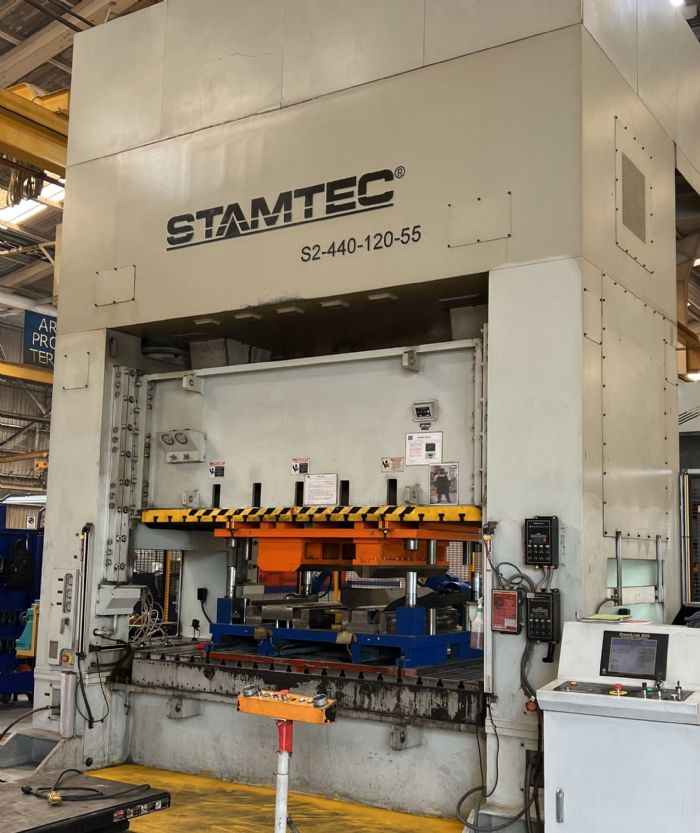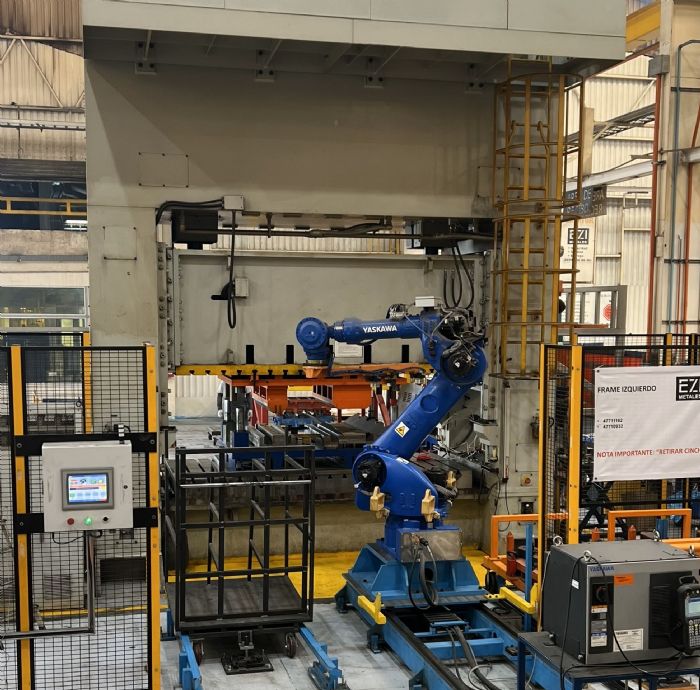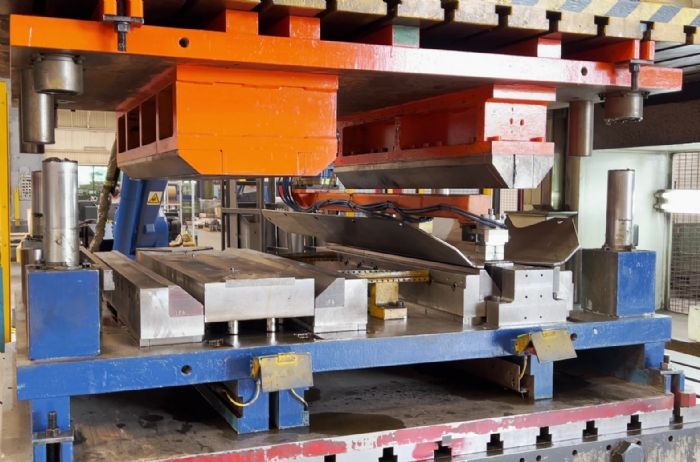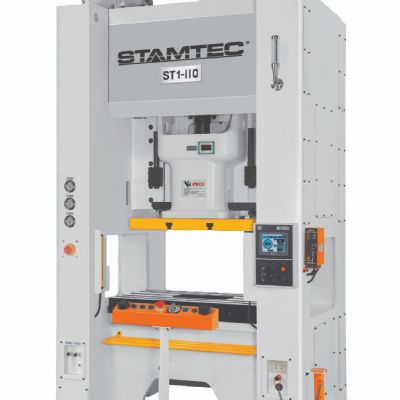Stamping Joins the Mix
What launched and grew as a metal fabrication business eventually evolved, starting in 2015, to include metal stamping, “as many of our customers that initially placed low- to midsized order volumes began to increase their demands for higher volumes,” Cisneros says. “One lower-volume product that might start with a laser and press brake, for example, suddenly would experience a growth in volume and we’d risk losing that business to a metal stamping company that could provide a more cost-effective solution. To keep those customers and products, therefore, we decided to invest in stamping equipment.
|
 The robot-tended Stamtec mechanical press features a fabricated steel frame of a heavy, box-type construction, fully thermal-stress-relieved before machining to ensure uniform accuracy. Stamtec rates the press bed to perform at no more than 0.0015 in. of deflection/ft. of bed length left to right and front to back. And, it notes that with the full-capacity load symmetrically distributed over two-thirds of the bed area, the press provides superior compressive strength, deflection, torsion and vibration resistance to help produce precision stampings with minimum die wear. The robot-tended Stamtec mechanical press features a fabricated steel frame of a heavy, box-type construction, fully thermal-stress-relieved before machining to ensure uniform accuracy. Stamtec rates the press bed to perform at no more than 0.0015 in. of deflection/ft. of bed length left to right and front to back. And, it notes that with the full-capacity load symmetrically distributed over two-thirds of the bed area, the press provides superior compressive strength, deflection, torsion and vibration resistance to help produce precision stampings with minimum die wear.
The press’s dual-valve automatic hydraulic overload-protection system protects each side of the press individually from overloads, relieving the pressure of a tonnage overload in milliseconds and quickly stopping slide movement.
Press control comes via a Link Systems OmniLink 5100-APC unit, with 10.4-in. touchscreen, eight inputs for die protection/process monitoring and eight programable limit switches to sequence and time automation with the press. Also available: four nine-digit counters for stroke, parts, batch and quality.
|
“But, we are not into stamping for very large progressive-die production,” Cisneros continues. “Our model is to stamp when projects that start in fabrication need to grow, and to also use stamping to perform forming operations that may be too complex or time-consuming to perform in a press brake. And, stamping also allows us to improve costs and quality for our customers, often providing tighter tolerances than press brake forming, which then helps our welding productivity.”
EZI Metals today counts four stamping presses in its arsenal, the largest a 440-metric-ton Stamtec two-point straightside mechanical press. With a 12-in. stroke length and 120 by 55-in. bolster area, “that press is used for the largest, heaviest parts that we stamp,” Cisneros says. Examples include a part for the food industry that requires embossing into the sheet, and an excavator door that requires forming of louvers.
“While we often can make louvers on our CNC punching machines,” Cisneros shares, “for the excavator door the louvers are 6 in. long, and stamping is the only way to form those. What’s interesting is how we can combine fabricating operations with stamping, and this excavator door is a great example. We form the louvers in the stamping press and then perform the rest of the forming operations in a press brake; it’s a very cost-effective and productive solution. The same product is fabricated in China at 10 times the volume, but rather than ship the parts from China the customer appreciates our cost-effective solution for manufacturing them here in North America.”
Robot Hired to Move Heavy, Large Blanks and Parts
Noting that the Stamtec press gives the firm “room to grow into larger parts,” Cisneros says it also gives the firm added flexibility to handle current work and to take on new work. “And, our customers have been very happy to send us larger jobs once they’ve learned we had this added capacity.”
However, with orders for larger and heavier parts come labor
challenges.
“When we bought the Stamtec press, one thing that I didn’t like: We needed two operators on the front of the press and two more on the back to handle part loading and unloading,” Cisneros says, “because the parts are relatively heavy and large. So, I challenged the team to add automation so that we can load and unload from the same side. We have achieved that.”
 The automation solution, installed at the Stamtec press
early in 2022: a Yaskawa robot arm mounted on a track. The robot destacks blanks and moves them into
the press, and also unloads stamped parts from the press and places them onto a
material-handling cart.
The automation solution, installed at the Stamtec press
early in 2022: a Yaskawa robot arm mounted on a track. The robot destacks blanks and moves them into
the press, and also unloads stamped parts from the press and places them onto a
material-handling cart.
 “We’ve gone from four operators on that press down to one,” Cisneros says. “With the robot, we’re handling blanks from 36 to 60 in. long and as thick as 3/16 in. Parts can weigh as much as 30 kg—that’s quite a job for manual labor to take on. Overall, the productivity from that press has increased by 25 percent or more with the robot. And, even though labor cost in Mexico remains competitive compared to other markets, we still find the need to automate wherever we can.”
“We’ve gone from four operators on that press down to one,” Cisneros says. “With the robot, we’re handling blanks from 36 to 60 in. long and as thick as 3/16 in. Parts can weigh as much as 30 kg—that’s quite a job for manual labor to take on. Overall, the productivity from that press has increased by 25 percent or more with the robot. And, even though labor cost in Mexico remains competitive compared to other markets, we still find the need to automate wherever we can.”
To be sure, EZI Metales is not new to robotics. As it has managed to grow considerably year
over year and expects to continue a rapid pace of growth through 2025 and
beyond, it has added robots to its welding department in a big way.
“The welding department often runs two shifts/day,” Cisneros says, “with some 70 manual welding booths and 20 welding robots. In fact, we expect that our continued growth pattern will require us to add a second shift to our stamping department.”
When to Convert a Fab Job to Stamping
When it comes time to decide between fabrication and
stamping a particular part, based on part volumes as well as on the projected
service life of a particular part, annual part runs of 12,000 seems to be the
tipping point, Cisneros says.
“At this level we typically can justify the cost of tooling for the press,” he shares. “We have some parts—for the food and medical industries, for example—that run at volumes of 100,000/yr. or more and which run most cost effectively in the presses. However, we also have to consider the overall projected life of parts when deciding to tool up for stamping. For example, we have some parts for the construction industry that might only run at an annual volume of 8000 to 10,000, but might be in use for several years, which can justify investing in a stamping die.”
Cisneros clearly sees stamping continuing to grow for the firm, as a way to keep current customers but also to attract new ones. While EZI Metales now operates some 18 laser cutting machines, six CNC punching machines and more than 30 press brakes (to 320-ton capacity), “we see stamping as becoming more and more important over time,” he says, “and without it as a core competency we probably would have lost some $3 to 4 million in annual sales over the last few years.” MF
Industry-Related Terms: Bed,
Case,
CNC (Computer Numerical Control),
Core,
Die,
Form,
Forming,
LASER,
Model,
Run,
StrokeView Glossary of Metalforming Terms
See also: Stamtec, Inc., Yaskawa America, Inc.
Technologies: Pressroom Automation, Stamping Presses







 The robot-tended Stamtec mechanical press features a fabricated steel frame of a heavy, box-type construction, fully thermal-stress-relieved before machining to ensure uniform accuracy. Stamtec rates the press bed to perform at no more than 0.0015 in. of deflection/ft. of bed length left to right and front to back. And, it notes that with the full-capacity load symmetrically distributed over two-thirds of the bed area, the press provides superior compressive strength, deflection, torsion and vibration resistance to help produce precision stampings with minimum die wear.
The robot-tended Stamtec mechanical press features a fabricated steel frame of a heavy, box-type construction, fully thermal-stress-relieved before machining to ensure uniform accuracy. Stamtec rates the press bed to perform at no more than 0.0015 in. of deflection/ft. of bed length left to right and front to back. And, it notes that with the full-capacity load symmetrically distributed over two-thirds of the bed area, the press provides superior compressive strength, deflection, torsion and vibration resistance to help produce precision stampings with minimum die wear. The automation solution, installed at the Stamtec press
early in 2022: a Yaskawa robot arm mounted on a track. The robot destacks blanks and moves them into
the press, and also unloads stamped parts from the press and places them onto a
material-handling cart.
The automation solution, installed at the Stamtec press
early in 2022: a Yaskawa robot arm mounted on a track. The robot destacks blanks and moves them into
the press, and also unloads stamped parts from the press and places them onto a
material-handling cart.  “We’ve gone from four operators on that press down to one,” Cisneros says. “With the robot, we’re handling blanks from 36 to 60 in. long and as thick as 3/16 in. Parts can weigh as much as 30 kg—that’s quite a job for manual labor to take on. Overall, the productivity from that press has increased by 25 percent or more with the robot. And, even though labor cost in Mexico remains competitive compared to other markets, we still find the need to automate wherever we can.”
“We’ve gone from four operators on that press down to one,” Cisneros says. “With the robot, we’re handling blanks from 36 to 60 in. long and as thick as 3/16 in. Parts can weigh as much as 30 kg—that’s quite a job for manual labor to take on. Overall, the productivity from that press has increased by 25 percent or more with the robot. And, even though labor cost in Mexico remains competitive compared to other markets, we still find the need to automate wherever we can.” 
